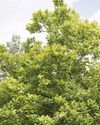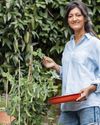
All plants have evolved within their environment to ensure their survival. In some parts of the world, plants have to cope with arid conditions, often not just dry but hot too. One of the adaptations plants use is to store water in their leaves. They go by the name of succulents from the Latin sucus, meaning sap or juice.
Succulents belong to many different plant families but share the common device of using their leaves and, in some cases, their stems as reservoirs so that in times of drought they remain turgid and can survive. Most cacti don't have leaves and it is their stems which act as reservoirs/water storage tanks. Remember, all cacti are succulents, but not all succulents are cacti!
Many succulents have a thick, waxy skin protecting the leaves from searing sun. And those leaves are often thick and fleshy because of the water-storing tissues within them. Waxy, hairy and spiny surfaces can create micro-climates around the leaves giving protection and reducing water loss. As a rule, succulents have fine, superficial roots evolved to collect any water around from showers to mist to dew. Some succulents have been known to survive for more than two years without any rain.
Although most originate in dry places, they tend to grow in communities, as desert sandstorms would quickly obliterate their seedlings or even the parent plants since they lack woody structures.
Carol's 10 star succulents
1 Kleinia stapeliiformis
Pickle plant or candlestick plant are other names. The flowers are big and a bit like hawkweed, to which it is distantly related, being in the daisy family. It spreads underground, throwing up new stems.
2 Crassula ovata 'Minima'
This story is from the February 2022 edition of Gardeners World.
Start your 7-day Magzter GOLD free trial to access thousands of curated premium stories, and 9,000+ magazines and newspapers.
Already a subscriber ? Sign In
This story is from the February 2022 edition of Gardeners World.
Start your 7-day Magzter GOLD free trial to access thousands of curated premium stories, and 9,000+ magazines and newspapers.
Already a subscriber? Sign In

A new plot for tasty crops
Taking on a new allotment needn't be hard work. By simply following a few easy tips you can have bumper crops in no time, just like Alessandro Vitale

We love July
July is an island floating between the joy of June and the slightly fatigued month of August. It's a grown-up month: the year has shrugged off its adolescent exuberances, the weather is (hopefully) warm enough for ice cream to be one of your five a day, the sea should be swimmable without (too much) danger of hypothermia and thoughts will be of holiday shenanigans and family barbecues. School's out this month, the next tranche of glorious summer colour is washing across our borders and it's my birthday. Lots of reasons to give three rousing cheers for July!

YOUR PRUNING MONTH
Now, at the height of summer, Frances Tophill shows how to boost your plants' health and productivity with a timely cut

Hassle-free harvests
Flowers are out in abundance this month and for Jack Wallington, many of these blooms make delicious, low-effort pickings

Bite-sized bounties
Glorious doorstep harvests can easily turn into gluts, so let Rukmini Iyer's recipes help you savour every last bit

Upcycled outdoor living
Create unique and stylish garden features for minimal cost using reclaimed materials and simple DIY skills. Helen Riches shares four step-by-step projects and more inspiring eco tips

Secrets of a COLOURFUL GARDEN
Buildings and landscapes can play a vital role in supercharging your space, as Nick Bailey demonstrates

Greening up a city balcony
Looking for sustainable, small-space gardening ideas? Take inspiration from Oliver Hymans' transformed balcony garden in north-east London - now a lush, green haven for humans and wildlife

The dry and mighty garden
As we adapt our gardens to a more volatile climate, Alan Titchmarsh reveals how to create a drought-tolerant plot and picks his top plant performers

Nature knows best
Carol Klein explains how to choose plants for specific growing conditions, based on what has naturally adapted to thrive there